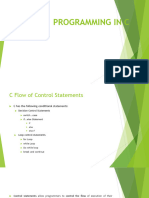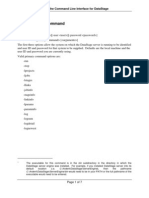Managing Transactions
Uploaded by
UsertouseManaging Transactions
Uploaded by
UsertouseOverview of Transactions
Managing Transactions
Example A The following code example shows how to name a transaction. USE AdventureWorks ; DECLARE @TranName VARCHAR(20) SELECT @TranName = 'MyTransaction' BEGIN TRANSACTION @TranName GO DELETE FROM AdventureWorks.HumanResources.JobCandidate WHERE JobCandidateID = 13 GO COMMIT TRANSACTION MyTransaction The following is the message displayed for the query. 1 row is affected. Example B The following code example shows how to mark a transaction with a specified name in the log. USE AdventureWorks ; BEGIN TRANSACTION CandidateDelete WITH MARK N'CandidateDelete' GO DELETE FROM AdventureWorks.HumanResources.JobCandidate WHERE JobCandidateID = 13 GO COMMIT TRANSACTION CandidateDelete GO The following is the message displayed for the query. 1 row is affected. Example C The following code example creates an explicit transaction and performs a couple of DML operations on the JobCandidate table. USE AdventureWorks ; BEGIN TRANSACTION GO UPDATE HumanResources.JobCandidate SET EmployeeID = 9 WHERE JobCandidateID = 1 DELETE FROM HumanResources.JobCandidate WHERE JobCandidateID = 13 GO COMMIT TRANSACTION The following is the message displayed for the query. 1 row is affected. 0 row(s) are affected. Example D
The following code example creates an explicit transaction, performs a DML operation, and shows how a ROLLBACK transaction nullifies the delete operation. BEGIN TRANSACTION GO SELECT * FROM HumanResources.JobCandidate WHERE JobCandidateID = 12 GO DELETE FROM HumanResources.JobCandidate WHERE JobCandidateID = 12 GO SELECT * FROM HumanResources.JobCandidate WHERE JobCandidateID = 12 GO ROLLBACK SELECT * FROM HumanResources.JobCandidate WHERE JobCandidateID = 12 GO The following is the message displayed for the query. 1 row is affected. 0 row(s) are affected.
JobCandidateID 12 9
EmployeeID
The following is the message displayed for the query. 1 row is affected. 1 row is affected. 0 row(s) are affected. The following is the partial result set of the query. JobCandidateID 12 9 EmployeeID
The following is the message displayed for the query. 1 row is affected.
You might also like
- I. Form Layout Single Record Dengan Binding Type Ado Data ControlNo ratings yetI. Form Layout Single Record Dengan Binding Type Ado Data Control40 pages
- Unit-2: Exception Handling & Transaction ManagementNo ratings yetUnit-2: Exception Handling & Transaction Management51 pages
- Imports Public Class Private As Public Sub New Byref As End SubNo ratings yetImports Public Class Private As Public Sub New Byref As End Sub5 pages
- Visual Basic Cheat Sheet: © Thecodingguys 2013No ratings yetVisual Basic Cheat Sheet: © Thecodingguys 201314 pages
- C# Operators - Arithmetic, Comparison, Logical and More - PDFNo ratings yetC# Operators - Arithmetic, Comparison, Logical and More - PDF17 pages
- SA0951a: Introduction To SQL: Structured Query LanguageNo ratings yetSA0951a: Introduction To SQL: Structured Query Language21 pages
- Introduction to Programming Using Visual Basic 2012 9th Edition Schneider Test Bank - Complete Set Of Chapters Available For One-Click DownloadNo ratings yetIntroduction to Programming Using Visual Basic 2012 9th Edition Schneider Test Bank - Complete Set Of Chapters Available For One-Click Download46 pages
- SQL 2012:usage of New Functions: Asanka PadmakumaraNo ratings yetSQL 2012:usage of New Functions: Asanka Padmakumara19 pages
- Steps To Connect Visual Basic & Oracle: A Tutorial by B.BhuvaneswaranNo ratings yetSteps To Connect Visual Basic & Oracle: A Tutorial by B.Bhuvaneswaran18 pages
- VB Migration Partner - Knowledge Base - The Execute Method of The ADODBNo ratings yetVB Migration Partner - Knowledge Base - The Execute Method of The ADODB1 page
- Membuat Database: Pemrograman Client-Server (Badiyanto, S.Kom., M.Kom)No ratings yetMembuat Database: Pemrograman Client-Server (Badiyanto, S.Kom., M.Kom)11 pages
- Nah Selanjutnya Copy Juga Kode Dibawah Ini Ke Form Tempat Datagrid Dan Tombol TadiNo ratings yetNah Selanjutnya Copy Juga Kode Dibawah Ini Ke Form Tempat Datagrid Dan Tombol Tadi1 page
- Replication of Company Code Data From CRM To ECCNo ratings yetReplication of Company Code Data From CRM To ECC9 pages
- SA0951a Oracle Practical: PL/SQL Cursors, Procedures, FunctionsNo ratings yetSA0951a Oracle Practical: PL/SQL Cursors, Procedures, Functions7 pages
- Introduction to Programming Using Visual Basic 2012 9th Edition Schneider Test Bankpdf download100% (1)Introduction to Programming Using Visual Basic 2012 9th Edition Schneider Test Bankpdf download51 pages
- Comment ouvrir un formulaire en mode ajout et autreNo ratings yetComment ouvrir un formulaire en mode ajout et autre2 pages
- Hacks To Crush Plc Program Fast & Efficiently Everytime... : Coding, Simulating & Testing Programmable Logic Controller With ExamplesFrom EverandHacks To Crush Plc Program Fast & Efficiently Everytime... : Coding, Simulating & Testing Programmable Logic Controller With Examples5/5 (1)



























































